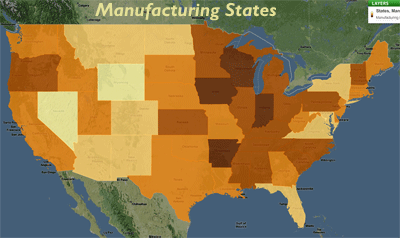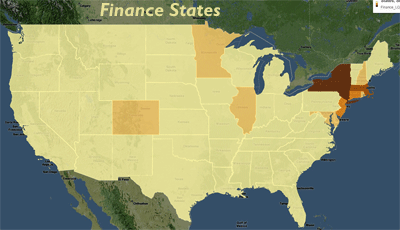NewGeography.com blogs
This probably won't shock you, but MapLight is reporting today that those House of Representatives members voting for the auto bailout received 65% more in campaign contributions from the auto industry than did those who voted against:
House Democrats voted overwhelmingly in favor of this bill, 205 voting Yes and 20 voting No (11 not voting). Democrats voting Yes received an average of $74,846 each, about 19% more than those voting No, who received an average of $63,140.
House Republicans were somewhat more divided on this bill, 32 voting Yes and 150 voting No (16 not voting). Republicans voting Yes received an average of $69,323 each, 63% more than those voting No, who received an average of $42,598.
MapLight charted a similar situation with the financial industry bailout.
On Monday, Creighton University's Economic Forecasting Group released the latest installment of the Mid-America Economic Survey. The survey of supply managers in nine plains states has been conducted monthly since 1994 to "produce leading economic indicators of the Mid-America economy." The survey provides a snapshot of economic activity in the states of Arkansas, Iowa, Kansas, Minnesota, Missouri, Nebraska, North Dakota, Oklahoma and South Dakota.
For November, the economic picture was less than positive. The survey's primary index hit a second straight all-time low in November, recording a score of 37.8. Any score below 50 "indicates a contracting economy over the next six to eight months." Only one state surveyed, North Dakota, showed a growing economy, with an index reading of 55.7, down from both September and October.
Employment prospects in the area were also negative, with the region showing "job losses for the tenth time in the past 11 months." This led to a "very weak" November employment index figure of 39.0, down from 49.7 in October, another record low. Creighton economics professor Ernie Goss, a member of the forecast group, expects "regional job losses to mount in the months ahead with rapidly rising unemployment rates for most states." According to Goss, the area is "now in a recession and I expect it to rival the recession of 1981-82 in terms of joblessness and job losses."
Echoing such findings today, the Federal Reserve released the latest edition of the Summary of Commentary on Current Economic Conditions, more commonly referred to as the Beige Book. According to the report, "overall economic activity weakened across all Federal Reserve Districts," with declines in retail sales, manufacturing activity, and housing prices being reported in nearly all districts. On the plains, the Minneapolis and Kansas City Fed districts both reported weaker overall economic activity.
Hopes for a quick rebound are subdued. According to the Kansas City Fed, their "business contacts expressed little optimism about economic activity going forward." The Mid-America survey reports that economic optimism "captured by the confidence index, slipped to another record low of 22.4" in November. While pockets of strength such as North Dakota remain, communities across the plains now face the prospect of a significant economic downturn.
Last week, Bismarck, ND was host to the second annual Great Plains Energy Expo and Showcase. Hosted by Bismarck State College and Senator Byron Dorgan, the conference focused on North Dakota's growing energy industry, including the wind energy sector, with presenters such as T. Boone Pickens discussing the opportunities and challenges facing the industry.
Wind is a readily available resource on the plains of North Dakota, which have been referred to as the "Saudi Arabia of wind". According to David Hadley of the Midwest ISO, a transmission coordination agency, North Dakota is the top state in the nation for wind energy potential. At 40% capacity, the state would have over 345,000 MW of potential generation capacity.
Current generating capacity is a minuscule fraction of this potential output. However, North Dakota has seen a major increase in investment in wind energy projects over the past several years. In 2005, there was only 80 MW of wind generation in the state. As of June, 2008, that number stands at "716 MW either in service or under construction, plus another 807.5 MW that has either been site permitted or is in some stage of the siting process." According to the Midwest ISO, potential North Dakota projects being discussed or currently under way add up to 7656 MW of potential generation. One major project under discussion would include 2000 MW of generation, costing around 4 billion dollars. The development is, in the words of one elected official interviewed by the Bismarck Tribune, "truly eye-popping."
Standing in the way of exploiting the Great Plains' wind bonanza is a major challenge- transmission capacity. North Dakota currently has a transmission export limit of 1950 MW, which is fully subscribed by current power producers. While several upgrades to the system are in the works, they will fall far short of the massive build up in transmission infrastructure needed to allow for continued rapid expansion of generation capacity. As one presenter at the Great Plains Expo put it, the region is "a victim of [its] own location."
In August the New York Times discussed the challenge posed by transmission limitations, noting that "North Dakota and South Dakota, could in principle generate half the nation’s electricity from turbines. But the way the national grid is configured, half the country would have to move to the Dakotas in order to use the power." If unaddressed, the inadequacy of the electric grid will serve as a check on energy driven economic development on the Great Plains. Rick Sergel, President of the North American Electricity Reliability Corp. (NERC), argues that "Without new transmission development needed to support these resources," it is likely "only a fraction," of currently proposed wind projects will be built. Speaking to Reuters, Sergel called for serious consideration of "comprehensive plans that cross state lines and international borders to build the clean-energy superhighway that will provide everyone equally with access to carbon-free generation".
It appears that expansion and modernization of transmission infrastructure will receive significant attention from the incoming administration. President-elect Obama stated in an interview on MSNBC that "the most important infrastructure projects that we need is a whole new electricity grid," and that he wants such projects "to be able to get wind power from North Dakota to population centers, like Chicago." With the current economic slowdown increasing calls for an economic stimulus package, investment in infrastructure, including grid expansion and modernization, appears set to take a central role in policy discussions in the coming year.
For our War of the Regions piece I went through BLS data and calculated location quotients for a few key diverging industries, namely manufacturing and securities, commodities and investments side of the finance industry. These are the kind of numbers that really benefit from geographic visualization.
A LQ tells us not where the most jobs are in any given industry, but how much of a state's employment is clustered in the given industry.
I've been following FortiusOne for a while but this is the first time I've gotten a chance to play around with their GEOCommons Finder! and Maker!, a new social production platform for agglomerating, sharing and visualizing geographic data. It's a fantastic platform.
 Click on the map images here to explore them on the GEOCommons platform. You can see a lot of dark color in the rust belt, but at this point, the states of Indiana, Wisconsin, Arkansas, Iowa, Alabama, and Mississippi are at or ahead of Michigan and Ohio in state dependence on Manufacturing. Part of this is due to growth in the South and Great Plains, and part is due to manufacturing job losses in the Rust Belt, causing the concentration there to slip. Click on the map images here to explore them on the GEOCommons platform. You can see a lot of dark color in the rust belt, but at this point, the states of Indiana, Wisconsin, Arkansas, Iowa, Alabama, and Mississippi are at or ahead of Michigan and Ohio in state dependence on Manufacturing. Part of this is due to growth in the South and Great Plains, and part is due to manufacturing job losses in the Rust Belt, causing the concentration there to slip.
 Finance here is limited to Securities, Commodity Contracts, and Other Financial Investments and Related Activities (NAICS 523). Not surprisingly, this industry is clustered in the Northeast. You see Illinois, Minnesota, and Colorado shaded darker due to the role of Chicago, Minneapolis, and Denver as regional trade centers. Finance here is limited to Securities, Commodity Contracts, and Other Financial Investments and Related Activities (NAICS 523). Not surprisingly, this industry is clustered in the Northeast. You see Illinois, Minnesota, and Colorado shaded darker due to the role of Chicago, Minneapolis, and Denver as regional trade centers.
Take some time to explore GEOCommons and some of the other visualizations created by others, and watch for more maps in this space as we do the same.
|














